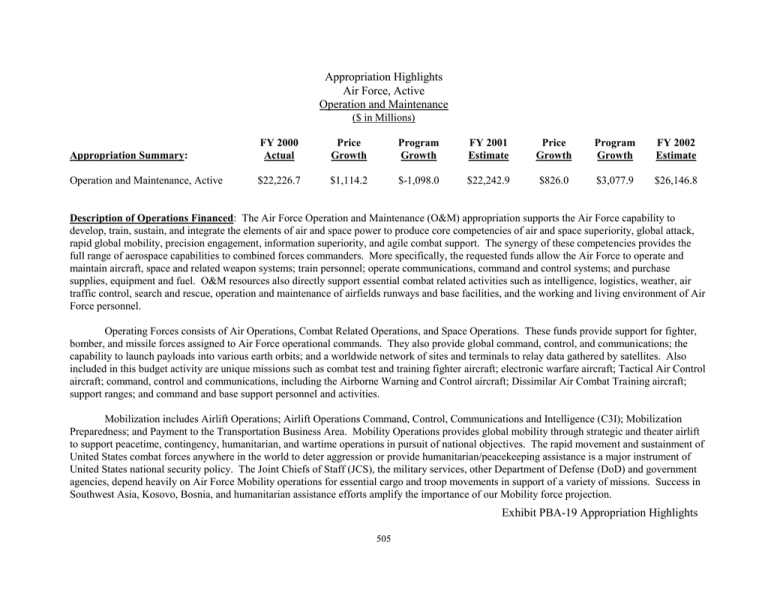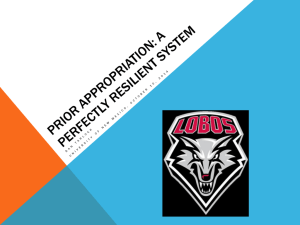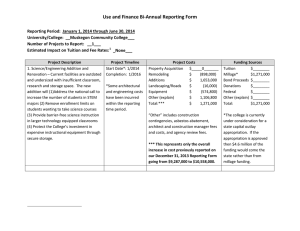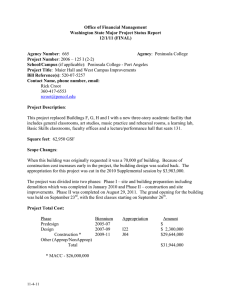Appropriation Highlights Air Force, Active Operation and Maintenance
advertisement

Appropriation Highlights Air Force, Active Operation and Maintenance ($ in Millions) Appropriation Summary: FY 2000 Actual Price Growth Program Growth FY 2001 Estimate Price Growth Program Growth FY 2002 Estimate Operation and Maintenance, Active $22,226.7 $1,114.2 $-1,098.0 $22,242.9 $826.0 $3,077.9 $26,146.8 Description of Operations Financed: The Air Force Operation and Maintenance (O&M) appropriation supports the Air Force capability to develop, train, sustain, and integrate the elements of air and space power to produce core competencies of air and space superiority, global attack, rapid global mobility, precision engagement, information superiority, and agile combat support. The synergy of these competencies provides the full range of aerospace capabilities to combined forces commanders. More specifically, the requested funds allow the Air Force to operate and maintain aircraft, space and related weapon systems; train personnel; operate communications, command and control systems; and purchase supplies, equipment and fuel. O&M resources also directly support essential combat related activities such as intelligence, logistics, weather, air traffic control, search and rescue, operation and maintenance of airfields runways and base facilities, and the working and living environment of Air Force personnel. Operating Forces consists of Air Operations, Combat Related Operations, and Space Operations. These funds provide support for fighter, bomber, and missile forces assigned to Air Force operational commands. They also provide global command, control, and communications; the capability to launch payloads into various earth orbits; and a worldwide network of sites and terminals to relay data gathered by satellites. Also included in this budget activity are unique missions such as combat test and training fighter aircraft; electronic warfare aircraft; Tactical Air Control aircraft; command, control and communications, including the Airborne Warning and Control aircraft; Dissimilar Air Combat Training aircraft; support ranges; and command and base support personnel and activities. Mobilization includes Airlift Operations; Airlift Operations Command, Control, Communications and Intelligence (C3I); Mobilization Preparedness; and Payment to the Transportation Business Area. Mobility Operations provides global mobility through strategic and theater airlift to support peacetime, contingency, humanitarian, and wartime operations in pursuit of national objectives. The rapid movement and sustainment of United States combat forces anywhere in the world to deter aggression or provide humanitarian/peacekeeping assistance is a major instrument of United States national security policy. The Joint Chiefs of Staff (JCS), the military services, other Department of Defense (DoD) and government agencies, depend heavily on Air Force Mobility operations for essential cargo and troop movements in support of a variety of missions. Success in Southwest Asia, Kosovo, Bosnia, and humanitarian assistance efforts amplify the importance of our Mobility force projection. Exhibit PBA-19 Appropriation Highlights 505 Appropriation Highlights Air Force Operation and Maintenance, Active Training and Recruiting supports three broad mission areas: Accession Training, Specialized Skills and Flight Training, and Recruiting & Other Training and Education. Accession Training operations produce the enlisted and officer personnel needed to meet total force requirements. Officer accessions receive indoctrination training through the United States Air Force Academy (USAFA), Air Force Reserve Officer Training Corps (AFROTC), Officer Accession and Training School (OATS), and Airmen Education and Commissioning Program (AECP). Specialized Skills provide Air Force personnel (and individuals of other services) training and education essential to operate, maintain, and manage complex Air Force weapon systems and associated support structure. Flying training programs include flight screening, undergraduate pilot training, specialized undergraduate pilot training (SUPT), specialized undergraduate and advanced navigator training, and pilot instructor training (PIT). Other training programs cover initial and follow-on technical skill progression training, professional military education, specialized professional development, and related training support. Administration and Servicewide funds four broad mission areas: Logistic Operations, Servicewide Support, Security Programs, and Support to Other Nations. Logistics Operations includes Air Force Logistics Operations, Technical Support Activities, Servicewide Transportation, and Base Support. It primarily funds the operation of Air Force Materiel Command (AFMC), which provides Air Force-wide cradle-to-grave acquisition and logistics support and comprises 90 percent of the resources in this activity group. The Servicewide Activities cut across the entire Air Force to ensure combat capability and maintain readiness, effective leadership, efficient management, and adequate support to Air Force units and personnel in diverse geographic locations. Much of this is accomplished via a number of highly specialized and unique Air Force organizations. The Security Programs includes the Air Force Office of Special Investigations (AFOSI) and a series of classified programs. Finally, the Support to Other Nations activity group provides support to the North Atlantic Treaty Organization (NATO); Supreme Headquarters Allied Powers Europe (SHAPE); North Atlantic Treaty Organization, other international headquarters. Exhibit PBA-19 Appropriation Highlights 506 Appropriation Highlights Air Force Operation and Maintenance, Active Overall Assessment: This budget places priority on improving readiness, with renewed focus on sustaining aerospace operations and training our people. Significant cost growth challenges efforts to maintain an aging aircraft fleet, meet contractual obligations comprising an increasing proportion of our budget, and to fund base support and infrastructure. We applied additional DoD Topline and reallocated Air Force resources to ensure we fund flying operations consistent with cost trends over recent years. Likewise, we addressed cost increases to support space and missile warning contracts, base maintenance contracts, utility rates, and communications networks. Concentrating on core combat readiness areas forced us to make tough choices affecting our facilities sustainment, restoration and modernization program. Budget Activity Operating Forces (BA-1) FY 2000 Actual Price Growth Program Growth FY 2001 Estimate Price Growth Program Growth FY 2002 Estimate $11,641.2 $558.9 $-693.1 $11,507.0 $470.9 $2,098.7 $14,076.6 Narrative Explanation of Major Changes by Budget Activity: Budget Activity 1: Operating Forces – Major Program Changes FY 2001 – FY 2002 The FY 2002 budget of 14,076M includes a price increase of $471M and program growth of $2,099M. Major changes include $421M transferred from the Overseas Contingency Operations Transfer Fund (OCOTF) for Southwest Asia contingency operations. Flying hours are fully funded based on annual cost factor updates and historic cost per flying hour trends, an increase of $819M. Contract logistics support and depot maintenance increased $280M and $50M, respectively, to meet escalating costs and increased frequency of maintenance, repairs, and inspections. Increased costs, predominantly higher contractual commitments supporting early warning sites brings a $70M increase. Space control/operations, including Spacetrack comprise a $42M increase. Launch facilities/vehicles increases $32M to standup EELV and to support the Patrick AFB joint contract. Finally, base support increases include $33M to meet higher utility costs and $47M to pay foundational Base Operating Support requirements. Facilities Sustainment, Restoration and Modernization program reflects internal realignments to fund core mission and contractual commitments, leaving this program funded at 86% of sustainment requirements. Exhibit PBA-19 Appropriation Highlights 507 Appropriation Highlights Air Force Operation and Maintenance, Active Budget Activity Mobilization (BA -2) FY 2000 Actual Price Growth Program Growth FY 2001 Estimate Price Growth Program Growth FY 2002 Estimate 3,111.9 291.5 -279.3 3,124.1 153.0 340.9 3,618.0 Budget Activity 2: Mobilization – Major Program Changes FY 2001 – FY 2002 The FY 2002 budget of $3,618M includes a price increase of $153M and program growth of $341M. Major changes include $164M transferred from the Overseas Contingency Operations Transfer Fund (OCOTF) for Southwest Asia contingency operations. Flying hour and aircrew training requirements increase $117M including annual cost factor and historic cost per flying hour trends, and lease and CLS of C-37 and C-40 aircraft. Maintenance for KC-10, C-9, and C-20 aircraft, plus transportation costs to Military Sealift Command make up another $81M increase. Budget Activity Training and Recruiting (BA- 3) FY 2000 Actual Price Growth Program Growth FY 2001 Estimate Price Growth Program Growth FY 2002 Estimate 2,033.2 105.9 71.7 2,210.8 53.1 235.8 2,499.7 Budget Activity 3: Training and Education – Major Program Changes FY 2001 – FY 2002 The FY 2002 budget of $2,500M includes a price increase of $53M and program growth of $236M. Major changes include $46M for increased Mission Critical Training, Level 1 and 7-Level (30% and 90% respectively), driven by Air Force accession and increased promotion objectives to address retention problems. Undergraduate flying training production increases $37M for instructor and logistics support contracts plus $31M for Air Force Cost Analysis Improvement Group (AFCAIG) approved cost per flying hour rates and aging aircraft. Recruiting and advertising increases $23M to support video production and Internet media as well as costs for 1,650 recruiters nationwide. Exhibit PBA-19 Appropriation Highlights 508 Appropriation Highlights Air Force Operation and Maintenance, Active Budget Activity Admin and Servicewide (BA- 4) FY 2000 Actual Price Growth Program Growth FY 2001 Estimate Price Growth Program Growth FY 2002 Estimate 5,440.4 157.9 -197.4 5,400.9 149.1 402.5 5,952.5 Budget Activity 4: Administration and Service-Wide – Major Program Changes FY 2001 – FY 2002 The FY 2002 budget of $5,952M includes a price increase of $149M and program growth of $403M. Major changes include $66M transferred from the Overseas Contingency Operations Transfer Fund (OCOTF) for Southwest Asia contingency operations. Increases of $44M include the increased cost for cargo movement to sustain warfighting capabilities overseas. The budget also includes a $242M increase to cover escalating depot repair costs incurred for aircraft, engines, missiles, and other major end items. Exhibit PBA-19 Appropriation Highlights 509




